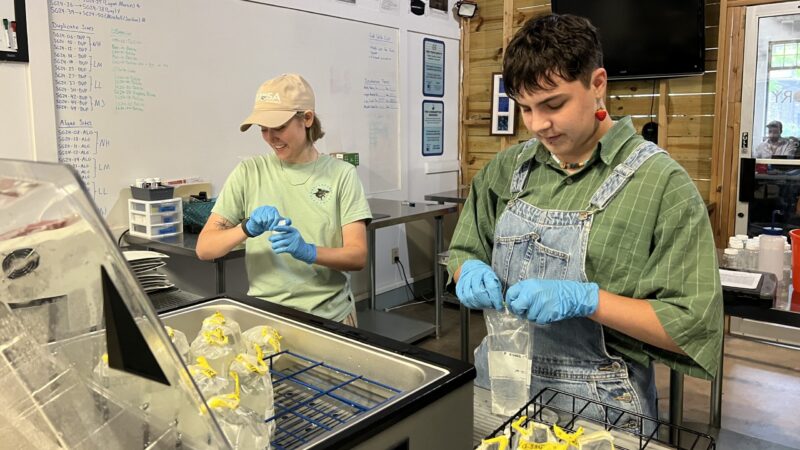Keeping the Coosa safe one bag of river water at a time
On a recent hot summer day, the chatter of Coosa Riverkeeper’s group of seasonal employees echoed around their office in Mount Laurel, southeast of Birmingham. They’d just returned from a long day of driving up to one hundred miles away from the office to their designated destinations — swimming holes along the Coosa River.
They had traveled to gather small plastic bags full of water from the river, each of which would soon be processed to retrieve essential data that keeps Alabamians safe.
Each summer, Coosa Riverkeeper publishes a virtual guide that shows the levels of contaminants at around fifty popular swimming holes on the Coosa River every week.
“Swim guide works to answer the simple question: is it safe to swim? We’re collecting water quality data to give a snapshot of the water quality at that time in place,” said Chad Hoffman, the program director of the nonprofit organization that works to protect Alabama’s Coosa River.
In the lab, the seasonal employees, almost all of whom are college students, test each sample for harmful contaminants like E. coli and algae blooms. Ashlyn Smith and Eli O’Connor unload the samples from coolers into a hot water bath to warm up the bacteria. They pour the water into glass jars, and a chemical is added.
“We’ll put the Colilert in them, which is just a little chemical we use to test the total coliform and the E.coli levels in each sample,” Smith said.
Then the chemical is mixed together with a quick shake of the bottle.
“After this is shaken up, it goes into one of these little trays. These are our little trays we use to test the coliform, test E.coli, all that good stuff,” Smith said.
The trays form a grid of small cubes. When water is poured in and the tray is pushed through a sealing machine, each cube is filled with a bit of water. Then the trays are all placed in an incubator.
In order to test for E. coli, the samples have to be encouraged to grow, which happens in the incubator.
“It will only grow based on how much is already in there. But it’s got to get cultured a little bit so we can visibly see it on a level we can understand,” O’Connor said.
After spending the night in the incubator, the trays are removed and placed under a black light
“If they glow, that’s E. coli,” Smith said with a laugh.
“Then we will take note of how many of them are glowing. And then we have a sheet that will turn that into a number that tells us if it’s too high of an E. coli level or if it’s a fine E. coli level,” said O’Connor.
He noted that E. coli will essentially always be present in any body of water.
“We just want to keep track of how much there is,” O’Connor said.
At the end of all of the testing, the data goes into a spreadsheet and is published on Coosa Riverkeeper’s website in a color-coded format, accompanied by a map that shows the safety of each swimming hole.
“On the map, we use a simple, green, yellow and red system,” Hoffman said. “Green being it’s safe to swim, yellow being, wait, we’ve had detections of some harmful E.coli, but it’s not enough to get sick, and then red is, according to EPA, 8 in 1000 people will contract a water borne illness at a red alert.”
A large part of Coosa Riverkeeper’s work is making scientific information more understandable — a crucial mission when their data can prevent someone from getting sick.
“We put it on a map, and we try to make it as easy to understand as possible, because science is not always easy to understand. And that’s a large barrier that we’re constantly working hard to try and find new and creative ways to make science easier to digest for people,” Hoffman said.
Coosa Riverkeeper has been publishing the swim guide for almost ten years. Hoffman said the idea came from a need to make information about water quality more readily available to the public. He’s witnessed how access to that information increases awareness of environmental issues and makes people more aware of the impact of their own actions.
“Swim guide does so much to educate people about water quality and the fact that just because water may look clear does not mean it’s safe,” he said. “So that really kind of gets people thinking more and more about their health, and then that gets people thinking more about what can they do to impact [the environment] in a more positive way,” he said.
Coosa Riverkeeper’s swim guide is also used as a tool to increase environmental awareness and action. The data collected is used year-round to fulfill Coosa Riverkeeper’s mission of protecting Alabama’s waterways.
“We use that data to write comment letters to the state and federal level. We use that data to investigate trends that we’re worried about, whether it’s a creek that has consistently high bacteria levels, which we’ll spend time investigating and trying to figure out what the source of that is and how we can come to a place to resolve it,” Hoffman said.
Hoffman said that above all, Coosa Riverkeeper just wants folks to get out there.
“Just go explore, whether that’s around the Coosa River or around Alabama, this state, this watershed, has so much to offer. And I think the more that folks are doing that, the more folks will think about water quality, the more folks will think about conservation. I think we have a lot that’s worth protecting here,” he said.
McLaren’s Lando Norris wins first F1 title at season-ending Abu Dhabi Grand Prix
Red Bull driver and defending champion Max Verstappen won the race with Norris placing third, which allowed Norris to finish two points ahead of Verstappen in the season-long standings.
A ban on feeding pigeons ruffles lots of feathers in Mumbai
The pigeon population has exploded — a result of people feeding the birds. For some it's a holy duty and a way to connect to nature. Critics point to health risks tied to exposure to pigeon droppings.
‘Rosemead’ tells a tragic — and true — story
The new movie stars Lucy Liu as an ailing mother to Joe, played by Lawrence Shou as a teenager facing mental illness in his feature debut role.
From 400-year-old globes to cosmic shrouds: A Maine library brings maps to life
From 400-year-old globes to cosmic funeral shrouds, how the Osher Map Library in Maine shows people that maps aren't just for navigation — but windows into history, culture, and how we see the world.
Benin’s interior minister says a coup announced earlier has been foiled
Earlier, a group of soldiers had appeared on Benin 's state TV Sunday to announce the dissolution of the government in an apparent coup, the latest of many in West Africa.
A fire at a popular nightclub in India’s Goa state kills at least 25, officials say
At least 25 people, including tourists, were killed in a fire at a popular nightclub in India's Goa state, the state's chief minister said Sunday.






